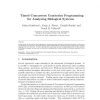106
Voted
NAR
2006
15 years 23 days ago
2006
The increasing amount of genomic and molecular information is the basis for understanding higherorder biological systems, such as the cell and the 15 organism, and their interacti...
115
Voted
ENTCS
2007
15 years 23 days ago
2007
In this paper we present our
rst approach to model and verify biological systems using ntcc, a concurrent constraint process calculus. We argue that the partial information const...
96
Voted
ENTCS
2007
15 years 23 days ago
2007
The use of process calculi to represent biological systems has led to the design of different formalisms such as brane calculi and κ-calculus. Both have proved to be useful to m...
128
click to vote
JCB
2006
15 years 23 days ago
2006
Biological systems are traditionally studied by focusing on a specific subsystem, building an intuitive model for it, and refining the model using results from carefully designed ...
93
Voted
JAL
2008
15 years 24 days ago
2008
Biological systems are far more complex and robust than systems we can engineer today. One way to increase the complexity and robustness of our engineered systems is to study how ...
107
Voted
ENTCS
2006
15 years 25 days ago
2006
In recent years, there has been increasing interest in computational models of biological systems based on various calculi of communicating processes, such as the stochastic pi-ca...
125
Voted
BMCBI
2006
15 years 26 days ago
2006
Background: Stochastic simulation has become a useful tool to both study natural biological systems and design new synthetic ones. By capturing the intrinsic molecular fluctuation...
131
Voted
BMCBI
2010
15 years 28 days ago
2010
Background: Many research results show that the biological systems are composed of functional modules. Members in the same module usually have common functions. This is useful inf...
BIOSYSTEMS
2008
15 years 28 days ago
2008
This paper investigates how self-organisation might be harnessed for the manipulation and control of calcium oscillations. Calcium signalling mechanisms are responsible for a numb...
BIOSYSTEMS
2007
15 years 28 days ago
2007
The structural organization of biological systems is one of nature’s most fascinating aspects, but its origin and functional role is not yet fully understood. For instance, basi...





